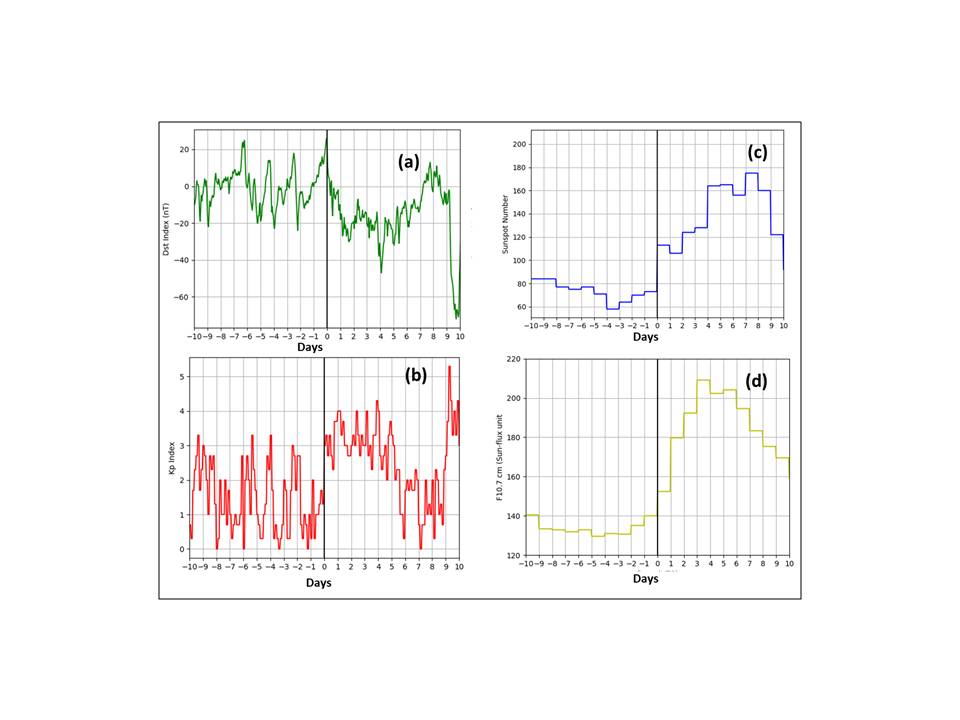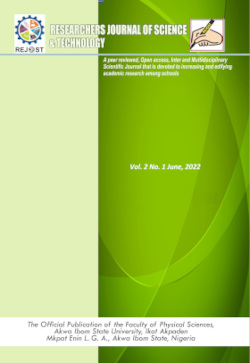Post seismo-ionospheric perturbations linked to the Turkey earthquake of February 6, 2023 using GPS-TEC data
Keywords:
Turkey, Earthquake, Perturbations, Ionospheric, GPS - TECAbstract
Seismo-ionospheric abnormalities are typically detected using total electron content (TEC) measurements taken from satellites. In this study, global positioning system (GPS) - TEC data from 3 sites in the seismic zone of the magnitude 7.8 Turkey earthquake (EQ) of February 6, 2023, were examined with the ultimate aim of detecting their possible link with the impending seismic event, to mitigate loss of lives and property. For the purpose of finding abnormal and differential TEC, a statistical approach was applied to daily TEC ten days pre- and ten days post the seismic event. The results showed that the investigation period days 1, 4, 8, and 9 showed enhancement in diurnal TEC, and that KABR and CSAR sites were the only sites that registered aberrant TEC. Results of the analysis, constrained by information from contemporaneously monitored geomagnetic indices of Kernnifzer digit (kp), disturbance storm time (Dst), and solar indices (sunspot number (SSN) and F10.7 cm), indicated post-seismic induced anomalies related to the earthquake on the 8th and 9th days after the event. The TEC differential data were notably high four days post-event. This led to the mapping of TEC indices on February 9 and 10, 2023, above the EQ epicenter to investigate anomalous coordinated universal time (UTC) hours correlating with the earthquake. The global ionospheric map GIM-TEC did not link the occurrence of anomalous ionospheric clouds over the epicenter to the seismic event. This work revealed post-seismo-ionospheric variations through GPS-TEC data concomitant to the M7.8 Turkey geo-quake of February 6, 2023, which served as a short-term earthquake indicator that may have mitigated the catastrophic loss of lives and properties from its numerous aftershocks. The perturbations on the 8th and 9th days post-event served as precursors to the M6.4 February 20th earthquake.
References
Akhoondzadeh, M., Parrot, M. and Saradjian, M.R. (2010). Electron and ion density variations before strong earthquakes (M> 6.0) using DEMETER and GPS data. Natural Hazards and Earth System Sciences, 10(1), pp.7-18. https://doi.org/-10.-5194/nhess-10-7-2010
Akpan, A.E., Ibanga, J.I., George, N.J. and Ekanem, A.M., (2019): Assessing seismo-ionospheric disturbances using Vanuatu and Honshu earthquakes of March 25, 2007, employing DEMETER and GPS data. International journal of environmental science and technology, 16, pp.7187-7196.https://doi.org/10.1007/s13762-019-02339-x
Dobrovolsky, I.P., Zubkov, S.I. and Miachkin, V.I., (1979): Estimation of the size of earthquake preparation zones. Pure and applied geophysics, 117(5), pp.1025-1044. https://doi.org-/10.1007/bf00876083
Eshkuvatov, H.E. Ahmedov, B.J.,Tillayev, Y.A., Arslan Tariq, M. Ali Shah, M., Libo Liu,(2023). Ionospheric precursors of strong earthquakes observed using six GNSS stations data during continuous five years (2011–2015), Geodesy and Geodynamics, 14, (1), 65-79, 1674-9847, https://doi.org/10.1016/j.geog.2022.04.002.
Geller, R.J., Jackson, D.D., Kagan, Y.Y. and Mulargia, F., (1997): Earthquakes cannot be predicted. Science, 275(5306), pp.1616-1616.https://doi.org/10.1126/science.275.5306.1616
Ibanga, J. I., Akpan, A. E., George, N. J., Ekanem, A. M. and George, A. M. (2017). Unusual ionospheric variations before the strong Auckland Islands, New Zealand earthquake NRIAG; J. Astron. Geophys. 7(1) 149–154, https://doi.org/ 10.1016-/j.nrjag.2017.12.007.
Ikeya, M., (2004): Earthquakes and animals: From folk legends to science. World Scientific. Singapore. https://doi.org/10.11-42/5382
Li, M. and Parrot, M., (2012): "Real time analysis" of the ion density measured by the satellite DEMETER in relation with the seismic activity. Natural hazards and earth system sciences, 12(9), pp.2957-2963. https://doi.org/10.5194/nhess-12-2957-2012
Liu, J.Y., Chuo, Y.J., Shan, S.J., Tsai, Y.B., Chen, Y.I., Pulinets, S.A. and Yu, S.B., 2004, April. Pre-earthquake ionospheric anomalies registered by continuous GPS TEC measurements. In Annales geophysicae (Vol. 22, No. 5, pp. 1585-1593). Göttingen, Germany: Copernicus Publications. https://doi.org/10.5194/angeo-22-1585-2004
Oikonomou, C., Haralambous, H., Pulinets, S., Khadka, A., Paudel, S. R., Barta, V. and İnyurt, S. (2020). Investigation of pre-earthquake ionospheric and atmospheric disturbances for three large earthquakes in Mexico. Geosciences, 11(1), 16.
Rishbeth, H., (2007): Do earthquake precursors really exist? Eos, Transactions American Geophysical Union, 88(29), pp.296-296. https://doi.org/10.1029/2007eo290008
Rostoker, G., (1972): Geomagnetic indices. Reviews of Geophysics, 10(4), pp. 935-950. https://doi.org/10.1029/rg010i00-4p00935
Thomas, J.E., George, N.J., Ekanem, A.M. and Ekpenyong, N.E., (2019): Ionospheric induced plasma disturbances afore the M7. 9 eastern Sichuan China earthquake of 12th May, 2008.International Journal of Advanced Geosciences. https://doi.org/10.-14419/ijag.v7i2.29980
Thomas, J.E., George, N.J., Ekanem, A.M. and Nathaniel, E.U., (2020a): Preliminary investigation of earth tremors using total electron content: a case study in parts of Nigeria. NRIAG Journal of Astronomy and Geophysics, 9(1), pp.220-225. https://doi.-org/10.1080/20909977.2020.1723866
Thomas, J.E., George, N.J., Ekanem, A.M. and Akpan, A.E., (2020b): Ionospheric plasma variations afore the east of Kuril Islands earthquake of 13th January, 2007. Geological Behavior, 4(1), pp.42-46. https://doi.org/10.26480/gbr.01.2020.42.46
Thomas, J.E., Ekanem, A.M., George, N.J. and Akpan, A.E., (2021): Electron temperature and ion density perturbations prior to the M 6.8 Eastern Honshu, Japan earthquake of July 23, 2008. Journal of Earth System Science, 130(3), p.134. https://doi.org-/10.1007/s12040-021-01645-8
Thomas, J.E., Ekanem, A.M., George, N.J. and Akpan, A.E., (2023): Ionospheric perturbations: a case study of 2007 five major earthquakes using DEMETER data. Acta Geophysica, 71(4), pp.1607-1618. https://doi.org/10.1007/s11600-023-01059-8
Thomas, J. E, Ben, U. C. Ekanem, A. M. George, N. J., Nathaniel, E. U. (2022): Seismo-ionospheric anomalies before M7.2 Haiti earthquake of August 14, 2021, from GPS-TEC, Acta Geophysica. https://doi.org/10.-1007/s1160 0-022-00903-7
Thomas, J. E. (2021): Lithosphere-atmosphere - Ionosphere coupling fog Pre-, Co- and post-earthquakes: a case study of Northern Mariana, USA earthquake of 31st October 2007. Res J Sci Technol 1(1):37–46
Thomas, J.E. (2020): SEISMO–Ionospheric Induced Perturbations Prior to the September 28, 2007 M7. 5 Northern Mariana USA Geoquake from GPS, TEC and DEMETER Data, Journal of Geosciences (MJG) 4 (1), 38-42
Thomas, J E; Nathaniel, E U; George, N J; Ekanem, A M and Akpan, S S (2024). Statistical analysis of detected ionospheric anomalies with earthquake magnitudes: A case study of the New Zealand earthquakes of March 4, 2021 Results in Earth Sciences 2, 100011
Vesnin, A., Yasyukevich, Y., Perevalova, N. and Senturk, E. (2023): Ionospheric Response to the 6 February 2023 Turkey–Syria Earthquake. Remote sensing 15(9), 2336; (https://doi.org/10.3390/rs15092336)
Xinzhi, W., Junhui, J., Dongjie, Y. and Fuyang, K. (2014): Analysis of ionospheric VTEC disturbances before and after the Yutian Ms7. 3 earthquakes in the Xinjiang Uygur Autonomous Region. Geodesy and Geodynamics, 5(3), pp.8-15.https://doi.org/10.3724/sp.j.1246.2014.03008

Downloads
Published
How to Cite
Issue
Section
License
Copyright (c) 2024 Researchers Journal of Science and Technology

This work is licensed under a Creative Commons Attribution-NonCommercial-NoDerivatives 4.0 International License.




